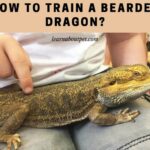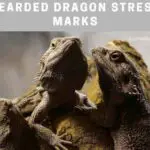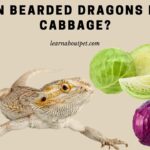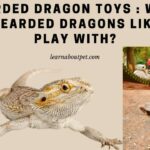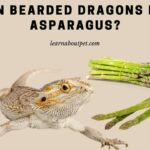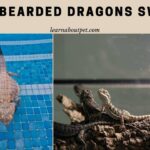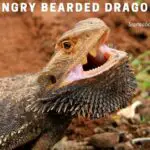Each one of us enjoys food and feels a sense of satisfaction after a delicious meal. Likewise, a bearded dragon enjoys its meals. As a loving owner of your pet, you feed it well to make sure your pet is happy. However, you might be misinformed about the right diet plan and end up having an overweight bearded dragon. To clarify this article is not written to shame a fluffy bearded dragon or a misinformed owner.
On the contrary, the article is meant to educate the owner on how to make sure they have a healthy bearded dragon that eats a well-balanced diet. Bearded dragon looks bloated?
What you have to know there is a reason why your beardie gets fat pretty quickly and might have a “bearded dragon fat belly”.
Having a fat bearded dragon is a normal function of a bearded dragon’s body to help them survive in the wild. Bearded dragons in the wild might sometimes not be able to find food for a couple of days. To survive, they have to get energy from their fat stored until they find food again. This ended up being their method of survival, and we should not just make jokes about “a bearded dragon fat belly” or make a fat bearded dragon meme on the internet. In addition to this, in captivity, a bearded dragon does not travel any distance to find food because food is provided, sometimes multiple times a day.
Bearded dragons are often claimed as lazy but they just conserve energy when there is no need to spend it.

This article will explore how you can identify if your bearded dragon’s weight is healthy. Also, to distinguish between the healthy bearded dragon fat pad and the overweight fat pads.
After reading this introduction and wondering: “is my bearded dragon fat?”, you should stick around and read more.
Why Does My Bearded Dragon Look Fat?
A fat bearded dragon is no accident, several reasons have caused this. Let us discuss the reasons why you ended up having an overweight bearded dragon with a bearded dragon fat belly.
Excessive food intake with low energy expenditure is a vital reason that can cause you to have a fat bearded dragon.
Not having an appropriate thermal gradient that allows a bearded dragon to move from high to low temperature on its demand. Also, if the night temperature is maintained consistently at high temperatures, this can increase the demand for food.
Similarly, if high temperatures are maintained frequently above the bearded dragon’s optimal temperature zone. Another reason you end up having a fat bearded dragon is not providing it with the conditions that help it brumate.
Excessively feeding calories to help your baby beardie grow rapidly will result in a fat baby bearded dragon as well.
Can A Bearded Dragon Be Obese?
The diet plan of a bearded dragon has a huge impact on its weight. If the diet is based on high protein intake with a low plant-based intake and excessive feeding. This diet can result in an obese bearded dragon.
For instance, A diet that has a high intake of mealworms and super worms is addictive to bearded dragons.
Instead, you can have more of a plant-based diet and replace those addictive treats with a couple of dubia roaches, locusts, and crickets per week.
Alongside meat treats, more greens like dandelion and chickweed. Since bearded dragons rarely indulge in a vegetable like turnip greens, you can mix it with some bee pollen that enhances bearded dragon’s appetite for them
Adding turnip greens to the bearded dragon diet is very essential to the health of your pet. Not enough exercise is why you might make your pet a chubby bearded dragon.
In captivity, bearded dragons do not get enough exercise because they live in small tanks, don’t hunt for food, and don’t dig enough. Also, you have to switch your bearded dragon’s lifestyle into a more active lifestyle.
How to Tell If Your Bearded Dragon Is Obese?
A good clue to whether you have a fat bearded dragon or not is checking the tail. Bearded dragons store fat in the base of their tail.
If it is a fat bearded dragon then the base of the tail will be wobbly and appear chubby. Otherwise, the tail is supposed to be round and solid for the normal bearded dragon. So, a bearded dragon fat tail is a great indicator of obesity.
Other clues mentioned earlier on how you know if you have a fat bearded dragon. 4 clues can help identify a fat bearded dragon.
| Body region | Clue to look for |
| Spine | Its spine and ribs are not felt |
| Abdomen | bloated abdomen, or bloated bearded dragon belly, is easily recognized |
| Jowl | droopy and heavy jowl is quite noticeable |
| Behind the arms | Fat pockets behind its arms will bulge. The bearded dragon fat pads on their heads are one of the clues to assess their body condition |
The curving of the head occurs because of the fat pads, and the bulge will feel squishy. The bulge does not indicate that it is a fat bearded dragon.
However, the degree of indentation could be used as a sign of an emaciated bearded dragon as its fat pads are reduced. Now you know how to decide if a bearded dragon looks fat.
What Is A Healthy Weight For A Bearded Dragon?
There is no one right answer to this question. Some individuals are meant to carry more weight than others and the opposite is true too. The key word that we should focus on is “Healthy.” Proper nutrition will allow all dragons to live long, healthy lives free from a variety of diseases and illnesses that arise due to improper dietary intake.
What needs to be kept in mind is that a beardie’s weight will be greatly dependent on the individual animal itself.
A well-nourished male will generally weigh more than a well-nourished female, and this is repeated for juvenile dragons vs. adult dragons. An adult female can attain an ideal weight of 900 grams whereas an adult male can weigh in excess of 1,500 grams.
It’s important to remember that these are only “ideal” weights and not all dragons will fit into this mold. Weight loss is a common occurrence when a bearded dragon first enters show room conditions; however, as long as body fat falls within the reference range, there should be little cause for concern.
The main reason for weight loss is due to the stress associated with being taken from their natural habitats and relocated to a whole new environment. A newly acquired dragon will generally exhibit behaviors that are an indicator of stress such as pacing, tail bobbing, excessive burrowing, and biting its own limbs. The dragon may also resist attempts at being handled by its owner.
A newly acquired dragon will gradually adjust to its new home; therefore, it’s important that the owner allow this adjustment period to take place in a calm and relaxed manner. It should also be stressed that when handling is attempted, one must remain patient because dragons are not toy-like animals and will become frightened if they feel threatened.
Healthy Weight Chart for Beardies
As with any animal on the market, the size of a bearded dragon can vary greatly depending on age, sex as well as genetics. The average length and weight of a bearded dragon is around 14-21 inches and 2.5-3.6 ounces for males and females respectively.
When Is It Time To Be Concerned With A Beardie’s Weight?
The rule of thumb for bearded dragons is they are considered overweight if their scales (without taking any fat rolls into account) exceed 30% of the general length of the dragon.
Please remember that what we consider an “ideal” weight may not necessarily coincide with the animal’s natural weight. Some dragons are bred to be on the smaller size and others are meant to be larger in structure.
The key is that the animal carries its weight proportionately; therefore, it must have sufficient body mass to support essential organs such as the heart, lungs, kidneys, liver, etc.
Most owners find it easier to use a food or water scale in order to monitor their dragon’s weight.
Why Is My Bearded Dragons Belly Big?
The dragon’s abdomen is actually comprised of two separate organs, the digestive system and the respiratory system. As with any living creature, these two systems must be kept in balance to ensure optimal functioning.
A slimmer abdominal region is indicative of a healthy reptile; therefore, it should not be considered an unnatural occurrence when bearded dragons are housed in proper environmental conditions.
Although there are many factors that can contribute to a large gut, the most common cause is overeating. Belly fat will not necessarily cause any health problems unless it begins to cover vital organs in which case an internal parasite may be present or the dragon may have eaten a foreign object, such as cloth material, and is unable to pass the material through his digestive system.
Another possible cause is a lack of exercise; therefore, it’s important to provide an opportunity for your bearded dragon to exercise and burn off energy. A simple change in diet will not make a big difference if the dragon is not allowed an opportunity to exercise.
If you are unwilling or unable to provide a larger enclosure, then offer a more varied diet so that the dragon is eating less food. Another option would be to switch out a higher fat food for a leaner chicken or crickets.
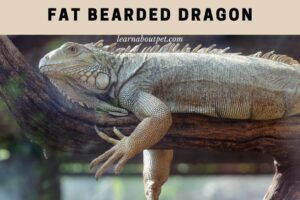
How Do I Know If My Bearded Dragon Is Too Fat?
Similar to humans, bearded dragons require a specific amount of food in order to maintain an ideal weight. A proper diet will also ensure that your dragon has the ability to grow at a healthy rate and live a long, happy life free from unnecessary health problems.
If you have access to a digital scale that measures grams (instead of ounces), then use it to accurately weigh your dragon.
If you do not have access to a scale, then use the following chart as a guideline:
Male dragons should fall within the range of 85-100 grams (3-4 ounces). Females are able to maintain their ideal weight at 80-115 grams (2.8-4.1 ounces).
The ideal amount of food can vary greatly depending on the metabolism (metabolism=how well a creature burns calories) and activity level of the dragon. For example, if your bearded dragon is an active eater (the type that constantly eat even when they are not hungry), then you may need to feed him more than what is listed on the chart.
If your dragon is overweight it will be easier to monitor changes in weight when he is on a controlled diet consisting of fewer calories.
Bearded dragons housed outside (not in an enclosure) are considered wild and their diet should consist mostly of live food items, such as crickets, worms, grasshoppers, or berries/fruit (if available in your region).
If you have not been able to determine the cause of your dragon’s weight gain, then please see a veterinarian who specializes in reptiles. The sooner you determine the cause of your dragons obesity, if any exists, the sooner he can begin his road to recovery. Excess belly fat should be removed only by a qualified veterinarian or certified reptile specialist.
Bearded dragons that are kept indoors should have an opportunity to exercise every day in order to burn off energy and maintain their ideal weight. A simple change in diet will not make a large difference if the dragon is not allowed an opportunity to exercise.
How Do You Fix A Bloated Bearded Dragon?
Although there are many factors that can contribute to a large gut, the most common cause is overeating. Belly fat will not necessarily cause any health problems unless it begins to cover vital organs in which case an internal parasite may be present or the dragon may have eaten a foreign object, such as cloth material and is unable to pass it through his digestive system.
Another possible cause is a lack of exercise; therefore, it’s important to provide an opportunity for your bearded dragon to exercise and burn off energy. A simple change in diet will not make a big difference if you are unwilling or unable to provide an opportunity for the dragon to get some much needed exercise.
If you are unwilling or unable to provide a larger enclosure, then offer a more varied diet so that the dragon is eating less food. Another option would be to switch out a higher fat food for a leaner chicken or crickets.
Additionally, if your dragon eats primarily crickets and other insects (rather than vegetables), you may need to feed them less often so that their body process the food more efficiently. Offer crickets or other insects for only two feedings per week and then offer vegetables (such as green beans, squash, peas) at least three times per week in order to maintain a healthy weight.
You can also help reduce belly fat by removing all unnecessary items from the dragons habitat, such as rocks, branches, and decorations. Bearded dragons spend an inordinate amount of time making a full circle around their habitat so the less items you have in their habitat the more exercise they will get per day.
What Should A Bearded Dragons Fat Pads Look Like?
The fat pads in a bearded dragons body should be approximately the same size or smaller than the space between his eyes. If they are significantly larger then that, he may need to lose weight.
What Do You Feed an Overweight Bearded Dragon?
It is important that you keep an eye on your pet’s weight and condition and especially a fat bearded dragon. Bearded dragon overweight can cause your pet serious health problems and affect its overall wellbeing.
Reducing body weight is through tackling food and creating a caloric deficit. You need your pet to use more energy than what it consumes.
As time passes, your pet’s body will use stored fat for energy, and body weight will decrease. You can start by reducing your fat bearded dragon food, so instead of two dozen crickets per day offer a lesser amount.
Make sure to decrease the amount of food or meals in a week gradually. It did not happen overnight all the gained bearded dragon fat, so slimming down is a process. Be patient and never starve your pet.
Another tactic to tackle is choosing food that has fewer calories. An overweight bearded dragon diet should consist of more vegetables and fruits than insects. Insects, like wax worms, have a lot more calories than other species.
Serving more vegetables in more quantities will ensure the bearded dragon is full and not hungry while cutting down weight.
You can still feed your bearded dragon insects like crickets and roaches, which have fewer calories than waxworms.
How Do I Know If I’m Overfeeding My Bearded Dragon?
Signs that your grown or baby bearded dragon has been overfed is the following
- fatigue
- lack of appetite
- bloated appearance (such as fat belly dragon)
- hindered movement in the hind legs
- difficulty to move the rear portion of the body
If you notice any of these symptoms make sure to contact your vet immediately. Especially if it is a fat baby bearded dragon because it could hinder your pet’s growth.
Remember, if the bearded dragon fat pads are chubbier, like a bearded dragon puffed up belly, it is a sign you are overfeeding your pet.
Make sure to weigh your pet regularly to monitor their growth, body condition, and overall health. Once a week is ideal, and record it in a journal.
Next, you can track your bearded dragon’s weight over time.
You can do that by using a digital scale that is accurate to 1-gram increments. Then put your beardie in any container in which it will rest while you’re obtaining his weight.
It’s often a good idea to write the weight of the container on the plastic somewhere because you will subtract it from your bearded dragon’s weight. So, you don’t have to re-weigh it each time.
Overweight Bearded Dragon Health Problems
Fat bearded dragons face serious health risks. An obese bearded dragon can have internal organ damage or dysfunction. A shortened lifespan resulting in premature death.
The normal weight for an adult bearded dragon is around 300-700 grams, and the fat pads on bearded dragon should not look fat while it’s walking and climbing.
Fat bearded dragons might also develop fatty liver disease. Unfortunately, this can be fatal to the fattest bearded dragons that have high-fat diets.
Fatty liver disease can also be fatal for bearded dragons’ that have metabolic disorders. Female bearded dragons might have dystocia which is difficult in labor or delivery.
How To Put Weight on a Bearded Dragon?
Some owners might struggle with a “bearded dragon fat belly”, on the flip side some owners struggle with an underweight bearded dragon.
An underweight bearded dragon looks weak with a flat belly and bones sticking out. It is important to note the issue of an undernourished bearded dragon because it might be fatal.
Check with your vet to rule out any health issues including parasites. You might need to rehydrate your bearded dragon by bathing or dropping water onto your pet’s mouth.
While, if the bearded dragon is starved you will need the vet’s support to set the correct diet and method to provide nutrients.
A bearded dragon fat belly or flat belly is a sign of obesity or undernourishment. Be careful with how much you feed your beardie.
Final Remarks On Fat Bearded Dragon
Having a bearded dragon bloated or bearded dragon belly, as we explored in the article is life-threatening. Your beardie’s weight whether underweight or overweight can be fatal.

Established in the article the overweight fat pads and how to recognize them on your pet. After recognizing you might have a bloated bearded dragon or overweight make sure to call the vet.
A healthy diet set by a vet goes a long way. To cut down on weight, the best method is putting your beardie in a caloric deficit. More greens like dandelion, chickweed, and turnip greens to make them feel full, and less fatty protein like wax worms. Since bearded dragons rarely indulge in vegetable turnips, greens can be mixed with some bee pollen that enhances the bearded dragon’s appetite for them.
On a final note, be patient with the weight loss process and as a caring owner reading this article reflects your love for your beardie.

Welcome to Learn About Pet. My name is Rajkumar Ravichandran and I love all pets, travel, and amazing food. I write about my passion and personal experience caring for multiple pets in this blog! ❤️
Post Disclaimer
DISCLAIMER: THIS BLOG OR WEBSITE, "Learn About Pet", DOES NOT PROVIDE YOU WITH MEDICAL ADVICE AND IS NOT A SUBSTITUTE FOR MEDICAL ADVICE. ALWAYS GET IN TOUCH WITH YOUR PERSONAL VETERINARIAN AND USE INFORMATION HERE AS GENERAL ADVICE.
The information, including but not limited to, text, graphics, images and other material contained on this website are for informational purposes only. No material on this site is intended to be a substitute for professional veterinary advice, food recommendation, diagnosis, or treatment. Always seek the advice of your veterinarian or other qualified health care provider with any questions you may have regarding a medical condition or for pet food related questions.
